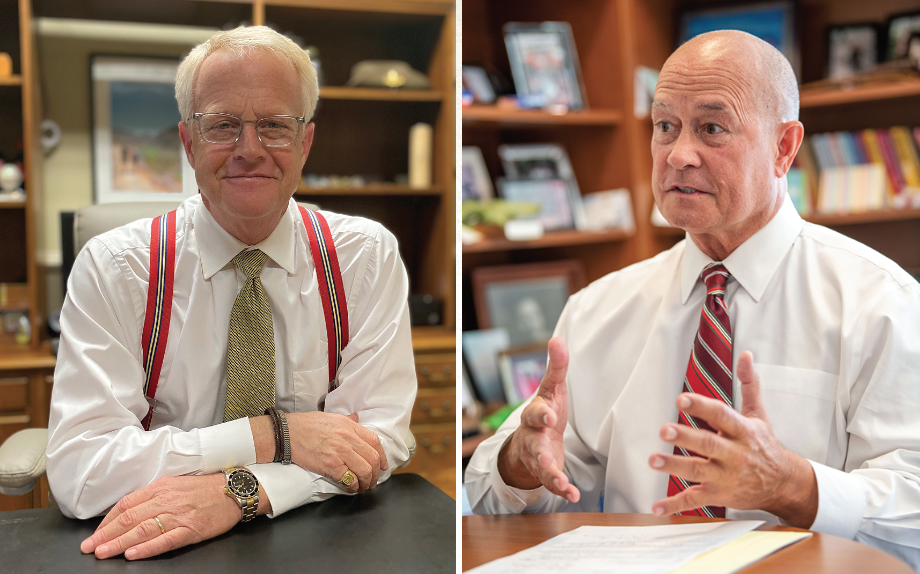How lessons in military leadership can help you thrive in the private sector

By Dave Ongie
There’s a reason why books like “Extreme Ownership: How U.S. Navy SEALS Lead and Win,” penned by retired Navy SEAL Jocko Willink, appeal to business leaders looking to hone their leadership and teambuilding skills. The parallels between being a successful leader in the military and being a successful leader in the business world are undeniable.
Here in our region, Miles Burdine and Jon Lundberg each developed their principles of leadership and teambuilding in the military while simultaneously applying them to their roles in the private sector.
Burdine, president and CEO of the Kingsport Chamber of Commerce, served in the United States Marine Corps and the USMC Reserves, retiring after 30 years with the rank of Colonel. Lundberg, president of The Corporate Image, spent 29 years in the Navy Reserve, where he served as a commanding officer of seven different units.
Burdine said managers and executives stand to learn a lot from leaders who have been successful in the military, but it ultimately comes down to what kind of culture they are trying to build within their organization.
“If you’re trying to build a culture that puts employees first, you ought to bring (retired military) guys in and let them do some training,” Burdine said. “If you don’t want a culture like that, don’t bring them in.”
When word started to spread around the halls of the Kingsport Chamber back in 1994 that the new boss was still in the Marine Corps, Burdine said there was some apprehension among the Chamber’s employees. But instead of barking orders, Burdine got to work building a culture around the mantra “Never above you, never below you, always beside you.”
“I wanted Marines to follow me because they wanted to follow me, to do what I wanted them to do because they wanted to do it, not because I told them to do it,” Burdine said. “There is a difference.”
Finding that balance between setting a high standard and holding people accountable while shouldering the blame as a leader when things go wrong can be difficult, but finding that balance is crucial to earning the buy-in from your employees that is the hallmark of any successful team. To sum up one of Willink’s core principles, teams celebrate wins and leaders shoulder the responsibility for the losses.
“Any really sound business owners will say, ‘The mistakes in this company, I made them.’ ” Lundberg said. “Can you say somebody else made the mistake? Sure they did. But I hired them. I trained them. I gave them whatever responsibility they had. So if there was a mistake made, ultimately it was mine.”
During his time in the Navy, Lundberg said he had the opportunity to learn from a lot of commanding officers, and the ones he learned the most from were the bad ones. A common trait of many of the ineffective leaders Lundberg observed was to lean on the top-down structure of the military where the stars or eagles on your collar make your words gospel to those serving under you.
As time went on, Lundberg learned to appreciate the COs who spelled out the objective and then took input on how to best accomplish the mission at hand. That, Lundberg said, allowed everyone to take ownership in the mission.
“Those are the leaders that build camaraderie,” he said.
That leadership lesson has served Lundberg well at The Corporate Image, a business that thrives on the creativity of the team Lundberg has put together.
“If I walk into a room and say this is what we’re going to do, and this is how we’re going to do it, I have deflated and removed every bit of creativity from this team,” he said. “I’ll kill creativity.”
If you peel back the layers of military leadership, what you’ll find at its core is servant leadership. Burdine said in the Marines the officers eat last. “If there isn’t enough food, you don’t eat,” he added.
Leadership is equipping your people with what they need to accomplish the mission at hand. If it results in victory, you celebrate together. If it results in defeat, the leader looks inward, accepts blame and refine his or her approach.
At the Kingsport Chamber, Burdine supports his employees when they need to go spent time with their families. He said instead of sneaking out early to watch their kids play soccer or perform in the school play, he encourages Chamber employees to “Leave loudly” by telling everyone where they’re going, which always sparks a positive reaction from the group.
“Anytime there is an opportunity for me to do something for them, I want to do it,” Burdine said.
As employers look for ways to coax employees back into the workforce in the wake of the COVID-19 pandemic, this aspect of military leadership may not be a bad place to start. Burdine admits to being a bit old-school, which was illustrated when he came to the office every day during the shutdown even though his employees were working from home. At first, he wondered how productive they were being out of the office, but when he saw they were getting their work done, he changed his thought process.
“I was concerned people weren’t doing their job, but I was wrong,” Burdine said. “It’s amazing how some people took that adverse situation and turned it into an opportunity to shine. So now, I’ve sort of adjusted my attitude. If you want to work from home some, that’s okay. Just get the job done. I think more and more employers are doing that.”
Allowing himself to admit when he was wrong was an early leadership lesson Lundberg remembers picking up while in the Navy. As he progressed, he learned many more, including the universal nature of motivation.
“Motivation is all the same – direction, vision, and standards,” he said. “You want to be very clear on what we’re going to do, how we’re going to do it, and everyone’s role in achieving that.”





